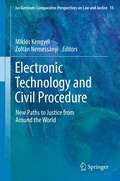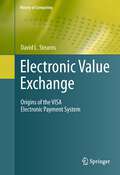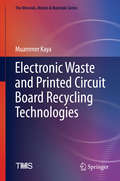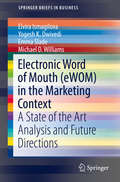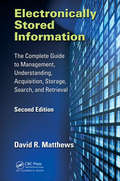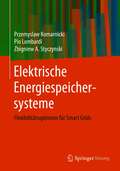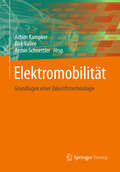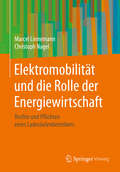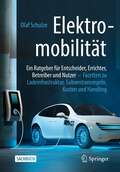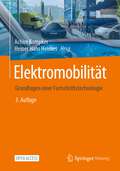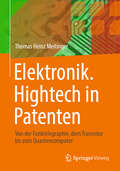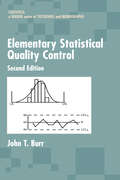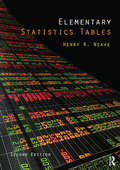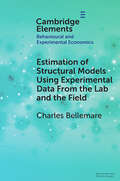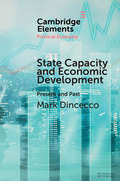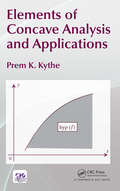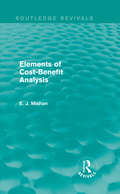- Table View
- List View
Electronic Technologies in the Information Mosaic: Where Managers Find Information
by William J. Bruns Jr. Sharon M. MckinnonAvailable technology should be a part of the solutions to serving managers' information needs, but technology alone will not guarantee better information for managers. It is important to design systems with managers' needs and preferences in mind.
Electronic Technology and Civil Procedure
by Zoltán Nemessányi Miklós KengyelThe effect of modern and communication technology on civil procedure first appeared on the agenda of the conference organized by the International Association of Procedural Law in 1999, verifying Lord Woolf's statement from the 90's, that "IT will not only assist in streamlining and improving our existing systems and process; it is also likely, in due course, itself to be catalyst for radical change as well...". At the conference in Pecs in the autumn of 2010 participants from three continents and twenty-five countries examined all aspects of the impact of modern information technology on civil procedure beginning with the electronic submission of the application, ranging from electronic service of documents and electronic means of proof supported by modern information technology. In addition to the practical issues they discussed the possible impact of electronic procedures on traditional principles of civil procedure. The conference book contains seven main reports and eleven correferates, the foreword was written by Prof. Peter Gottwald, the President of the International Association of Procedural Law.
Electronic Value Exchange
by David L. StearnsElectronic Value Exchange examines in detail the transformation of the VISA electronic payment system from a collection of non-integrated, localized, paper-based bank credit card programs into the cooperative, global, electronic value exchange network it is today. Topics and features: provides a history of the VISA system from the mid-1960s to the early 1980s; presents a historical narrative based on research gathered from personal documents and interviews with key actors; investigates, for the first time, both the technological and social infrastructures necessary for the VISA system to operate; supplies a detailed case study, highlighting the mutual shaping of technology and social relations, and the influence that earlier information processing practices have on the way firms adopt computers and telecommunications; examines how "gateways" in transactional networks can reinforce or undermine established social boundaries, and reviews the establishment of trust in new payment devices.
Electronic Waste and Printed Circuit Board Recycling Technologies (The Minerals, Metals & Materials Series)
by Muammer KayaThis book covers state-of-the-art technologies, principles, methods and industrial applications of electronic waste (e-waste) and waste PCB (WPCB) recycling. It focuses on cutting-edge mechanical separation processes and pyro- and hydro-metallurgical treatment methods. De-soldering, selective dismantling, and dry separation methods (including the use of gravity, magnetic and electrostatic techniques) are discussed in detail, noting the patents related to each. The volume discusses the available industrial equipment and plant flowsheets used for WPCB recycling in detail, while addressing potential future directions of the field. This practical, comprehensive, and multidisciplinary reference will appeal to professionals throughout global industrial, academic and government institutions interested in addressing the growing problem of e-waste. Covers principles, methods and industrial applications of e-waste and PCB recycling;Details state-of-the-art mechanical separation processes and pyro- and hydro-metallurgical treatment methods; Describes the available industrial equipment used and plant flowsheets for PCB recycling and addresses potential future developments of this important field.
Electronic Word of Mouth (eWOM) in the Marketing Context
by Yogesh K. Dwivedi Elvira Ismagilova Emma Slade Michael D. WilliamsThis SpringerBrief offers a state of the art analysis of electronic word-of-mouth (eWOM) communications and its role in marketing. The book begins with an overview of traditional word-of-mouth (WOM) and its evolution to eWOM. It discusses the differences between traditional and online WOM. The book examines why people engage in eWOM communications, but also how consumers evaluate its persuasiveness. It also looks at the effects of eWOM. The book identifies current gaps in the eWOM research, but also highlights future directions for this growing field. eWOM is an important marketing technique in brand communications, and it plays an important role in modern e-commerce. Marketers become extremely interested in enhancing the power of eWOM developing loyalty programs and building brands. Studying the effect of eWOM can be beneficial for companies. This book should be a good resource for scholars and practitioners that need to understand the pervasive effects of eWOM.
Electronically Stored Information: The Complete Guide to Management, Understanding, Acquisition, Storage, Search, and Retrieval
by David MatthewsAlthough we live in an era in which we are surrounded by an ever-deepening fog of data, few of us truly understand how the data are created, where data are stored, or how to retrieve or destroy data—if that is indeed possible. This book is for all of you, whatever your need or interest. <p><P>Electronically Stored Information: The Complete Guide to Management, Understanding, Acquisition, Storage, Search, and Retrieval, Second Edition explains the reasons you need to know about electronic data. It also gets into great detail about the how, what, when, and where of what is known in legal circles as electronically stored information (ESI). <p><P>With easy-to-understand explanations and guidelines, this book provides the practical understanding you need to effectively manage the complex world of ESI. Whether you are an attorney, judge, paralegal, business manager or owner, or just one of the ever-growing population of computer users, you will benefit from the information presented in this book.
Elektrische Energiespeichersysteme: Flexibilitätsoptionen für Smart Grids
by Zbigniew A. Styczynski Przemyslaw Komarnicki Pio LombardiMit den Methoden zur Modellierung, Planung und Implementierung elektrischer Energiespeichersysteme führt dieses Lehrbuch in ein zunehmend wichtiges Thema ein. Aufgrund der höheren Volatilität und zunehmenden Stromgestehung aus erneuerbarer Energie ist Energiespeicherung notwendig, um weiterhin eine sichere Versorgung zu gewährleisten.Einen technisch zuverlässigen und marktorientierten Speichereinsatz erfordert Entwicklung und Erprobung von verschiedenen Methoden der Planung und Betrieb von Energiespeichersystemen und deren Anpassung auf ihren Anwendungsfall, also Integration mit Energieerzeugung, Last oder Verteil. Bzw. Übertragungsnetz. Diese möglichen Ansätze, deren Anforderungen und Potenziale werden im diesen Buch beschrieben und mittels praktischen Beispielen diskutiert.
Elektrische Energieversorgung 2: Energiewirtschaft und Klimaschutz, Elektrizitätswirtschaft und Liberalisierung, Kraftwerktechnik und alternative Stromversorgung, chemische Energiespeicherung
by Valentin Crastan Michael HöckelDer hier vorliegende zweite Band des dreiteiligen Werkes „Elektrische Energieversorgung“ widmet sich den Aufgaben der Energiewirtschaft inklusive der Aspekte zum Klimaschutz sowie der Beschaffenheit des Energiemarktes. Kraftwerktechnik sowie Anlagen zur Stromerzeugung aus regenerativen Energiequellen und Energiespeicherung runden diesen Band im Bereich Elektrizitätswirtschaft ab.Alle drei Bände Elektrische Energieversorgung zeichnen sich durch die Synthese von theoretischer Fundierung und unmittelbarem Praxisbezug aus. Sie unterstützen das Verständnis und den Lernerfolg mit Übungsaufgaben, Modellbeispielen bzw. Simulationen.
Elektrizitätswirtschaft: Eine praxisorientierte Einführung in Strommärkte und Stromhandel
by Tim WawerDas Stromsystem der Zukunft ist erneuerbar. Durch die dezentralen erneuerbaren Energien ist die gesamte Elektrizitätswirtschaft im Umbruch. Der Wandel der Elektrizitätswirtschaft erfordert interdisziplinäre Betrachtungen, bei denen technische, politische, rechtliche und ökonomische Aspekte berücksichtigt werden.Dieses Buch vermittelt die Grundlagen, um in der Elektrizitätswirtschaft erfolgreich operativ und strategisch tätig zu werden. Die komplexen Zusammenhänge der Strommärkte werden verständlich dargestellt. Anhand einer Vielzahl von Beispielen und Abbildungen wird anschaulich gezeigt, wie Stromsysteme mit sehr hohen Anteilen erneuerbarer Energien – bis hin zu 100 % – funktionieren können.
Elektromobilität
by Achim Kampker Armin Schnettler Dirk ValléeDas Buch gibt einen umfassenden Überblick über die Herausforderungen und Lösungen zum Thema Elektromobilität. Von Gestaltungshinweisen bei der Konstruktion des Antriebsstrangs bis hin zu Ansätzen zum Aufbau der Infrastruktur wird ein breites Feld an Themen beleuchtet. Das Buch gliedert sich in fünf Kapitel. In einem Grundlagenkapitel werden die Herausforderungen der Elektromobilität sowie der Ansatz einer integrierten Produkt-, Prozess- und Infrastrukturentwicklung skizziert. Im Kapitel Elektromobilproduktion wird der Prozess der Industrialisierung eines Produktes und die Produktion der Antriebskomponenten dargestellt. Ansätze des Innovationsmanagements und das Thema wirtschaftlicher Leichtbau finden sich im Kapitel Automotive Engineering wieder. Das Kapitel Infrastruktur beinhaltet die Konzepte zum Aufbau eines Servicenetzes und beim Städtebau. Die notwendigen Rechtsgrundlagen und Strategien zur Geschäftsmodellentwicklung werden im Kapitel Business Conception erläutert.
Elektromobilität und die Rolle der Energiewirtschaft: Rechte und Pflichten eines Ladesäulenbetreibers
by Marcel Linnemann Christoph NagelElektromobilität ist spätestens seit dem Pariser Klimaschutzabkommen und Fridays for Future im Fokus der Öffentlichkeit. Bis 2030 soll 20 % des Verkehrs elektrisch fahren. Diesbezüglich stehen oft die technischen Herausforderungen der Elektromobilität im Vordergrund. Die grundsätzlichen Fragen der Energiewirtschaft stehen oft im Hintergrund: Welche Aufgabe hat welche Marktrolle (Netz, Vertrieb, MSB…)? Welche Marktrolle nimmt der Ladesäulenbetreiber ein? Wie wird mit Drittstrommengen durch Ladesäulen auf Betriebsgeländen umgegangen? Diese Fragen und vieles mehr, soll das Buch: Die Rolle des Ladesäulenbetreibers, Elektromobilität in der Energiewirtschaft beantworten. Im Gegensatz zu bestehender Literatur soll nicht die Integration in die Stromnetze oder der Aufbau eines E-Autos im Vordergrund stehen, vielmehr sollen die energiewirtschaftlichen Zusammenhänge und Aufgaben der Marktrollen im Vordergrund stehen. Das Buch soll den klaren Fokus haben, Praktiker in ihrem Arbeitsalltag zu unterstützen.
Elektromobilität – ein Ratgeber für Entscheider, Errichter, Betreiber und Nutzer: Facetten zu Ladeinfrastruktur, Subventionsregeln, Kosten und Handling
by Olaf SchulzeE-Mobilität ist komplex, alle Betroffenen haben gleichen Fragen. Das Buch soll Antworten geben auf die Entscheidung über die nötige und benötigte Ladeinfrastruktur von Ladetechnik, Netzanschluss, Handling, Kostenkalkulation, Nutzerverhalten, E- Fahrzeuge und deren netzdienliches Ladeverhalten, gesetzliche Regelungen für E-Mobilität und Operation, Abrechnung bis zu Webportalen. Es soll Entscheidungshinweise für verschiedene Stakeholder und Entscheiderebenen geben, natürlich auch Wirtschaftlichkeitserwägungen beschreiben. Das Sachbuch soll Trends, Unwägbarkeiten, Regulierungen und internationale Entwicklungen beinhalten und mit einem kritischen Selbstversuch- von der Anschaffung über das Fahren, Laden, App-Anwendungen abschließen. Leser sind Unternehmen, Organisationen und Privatleute, die E-Mobilität in Logistik, Belieferung, Transport und PKW einsetzen wollen.
Elektromobilität: Grundlagen einer Fortschrittstechnologie
by Achim Kampker Heiner Hans HeimesDieses Buch ist eine „Open Access“-Publikation zum Stand der Entwicklung der Elektromobilität. Ohne Zweifel: Die Automobilindustrie befindet sich in einem tiefgreifenden Wandel. Mit der Elektromobilität verändern sich bisherige Fahrzeug- und Antriebskonzepte grundlegend. Bestimmt durch neue Fahrzeugkomponenten wie die Batterie, die Leistungselektronik, der Elektromotor und die Brennstoffzelle, verändert sich der gesamte Wertschöpfungsprozess. Dieses Werk liefert einen umfassenden Überblick zu den Herausforderungen und Lösungen in sämtlichen Bereichen: von der Produktentwicklung über die Herstellung von Elektrofahrzeugen bis hin zum Aufbau einer Infrastruktur, zu neuartigen Geschäftsmodellen und den Potentialen der Nachhaltigkeit. Wie weit reicht die Geschichte der Elektromobilität zurück? Welche spezifischen Systeme finden sich im Elektromobil wieder und wie werden sie bis hin zum gesamten Fahrzeug hergestellt? Welchen technischen und gesetzlich-regulatorischen Rahmenbedingungen unterliegt die E-Mobilität? Wie ist es um die notwendige Infrastruktur bestellt? Welche neuen Geschäftsmodelle entstehen entlang der elektromobilen Wertschöpfungskette? Und wie nachhaltig ist die Elektromobilität tatsächlich? Antworten auf diese und andere Fragen liefert dieses Buch in sieben informativen Kapiteln. Für die dritte Auflage wurden sämtliche Inhalte neu strukturiert und auf den aktuellen Stand der technologischen Entwicklung gebracht.
Elektromobilität: Grundlagen einer Zukunftstechnologie
by Achim Kampker Armin Schnettler Dirk ValléeDie Automobilindustrie befindet sich in einem tiefgreifenden Wandel. Mit der Elektromobilität verändern sich bisherige Fahrzeug- und Antriebskonzepte grundlegend – und damit auch der gesamte Wertschöpfungsprozess. Das Buch liefert einen umfassenden Überblick über die Herausforderungen und die Lösungen zu allen Aspekten der Elektromobilität: von der Produktentwicklung über die Produktion von Elektrofahrzeugen mit Hinweisen für die Konstruktion des Antriebsstrangs bis hin zum Aufbau einer Infrastruktur und zu Geschäftsmodellen. Für die zweite Auflage wurden sämtliche Inhalte auf den aktuellen Stand der technologischen Entwicklung gebracht. Das Thema Batterieproduktion wurde ebenso erweitert wie die damit verknüpfte Frage des Remanufacturings als Teil des Recycling-Kreislaufes. Das Buch gliedert sich in fünf Kapitel. Im Grundlagenkapitel werden die Herausforderungen der Elektromobilität beschrieben und die Ansätze für eine integrierte Produkt-, Prozess- und Infrastrukturentwicklung skizziert. Darüber hinaus bietet es umfassende Einblicke in die Montage von Elektrofahrzeugen. In den folgenden Kapiteln werden Konzepte für den Städtebau und für den Aufbau eines Servicenetzes vorgestellt sowie Geschäftsmodelle, ihre Entwicklung und Rechtsgrundlagen erläutert. Im Kapitel Fahrzeugkonzeption geht es um den Prozess der Industrialisierung und Fragen der Batterieproduktion. Die Entwicklung von elektrofahrzeugspezifischen Komponenten wie der des Antriebsstrangs wird im abschließenden Kapitel „Entwicklung von elektrofahrzeugspezifischen Systemen“ beschrieben.
Elektronik. Hightech in Patenten: Von der Funktelegraphie, dem Transistor bis zum Quantencomputer
by Thomas Heinz MeitingerElektronische Schaltungen werden heutzutage zumeist aus kristallinen Halbleitern hergestellt, in die Fremdatome eingebracht werden (Dotierung). Die Anfänge der Elektronik kennzeichnen jedoch die Elektronenröhren, mit denen die ersten gleichrichtenden und schaltenden Funktionen verwirklicht wurden. Die ersten, auf dieser Technologie basierenden Computer hatten eine geringe Leistung, wiesen dennoch gewaltige räumliche Ausmaße auf. Erst mit der Verwendung von dotierten Halbleitern begann die Miniaturisierung und die dynamische Entwicklung der Elektronik. Dieses Buch zeigt die Entwicklung der hierfür erforderlichen Elektronik von der Analogtechnik mit den Operationsverstärkern über die Digitaltechnik, die letzten Endes ins Computerzeitalter geführt hat, und der Hochfrequenztechnik, die entscheidend die Nachrichtenübertragung bestimmt hat, bis hin zur Leistungselektronik, die eine elektrische Energieversorgung ermöglicht. In diesem Buch werden die hierfür benötigten Erfindungen und die resultierende technische Entwicklung anhand der Hauptansprüche und Zeichnungen aus Patentschriften vorgestellt.
Elektrosmog und Ökoboom: Ein naturwissenschaftlicher Blick auf populäres Halbwissen
by Werner MänteleWas ist wirklich dran an den Gefahren durch Elektrosmog, Gentechnik und Radioaktivität? Sind die Risiken durch Feinstaub und Stickoxide in unseren Städten tatsächlich so groß, wie oft behauptet wird? Gibt es Gründe zu glauben, dass Funkmasten und Hochspannungsleitungen unsere Gesundheit gefährden? Und ist „Öko…” automatisch immer gut? Dieses Buch geht solchen Fragen mit einer soliden wissenschaftlichen Arbeitsweise nach. Es hilft Ihnen dabei, den Hintergrund der befürchteten Risiken zu verstehen und mögliche Gefahren, aber auch Chancen richtig einzuordnen. Von der Mobiltelefonie über die Energiewende bis zur Gentechnik behandelt das Buch Themen, die in unserer Gesellschaft sehr kontrovers und teilweise emotional diskutiert werden. Der Autor führt Sie kurzweilig durch die wissenschaftlichen Grundlagen und klärt Sie mit Augenzwinkern über populäre Irrtümer und Fehlvorstellungen auf. Er zeigt Ihnen, wie Sie in Medien oder im Internet Quellen für solide Informationen finden, denen Sie vertrauen können und die nicht von Ideologien geprägt sind. So ermöglicht die Lektüre des Buches Ihnen ein eigenes, wissenschaftlich begründetes Urteil.
Elementary Financial Derivatives
by Jana SacksA step-by-step approach to the mathematical financial theory and quantitative methods needed to implement and apply state-of-the-art valuation techniques Written as an accessible and appealing introduction to financial derivatives, Elementary Financial Derivatives: A Guide to Trading and Valuation with Applications provides the necessary techniques for teaching and learning complex valuation techniques. Filling the current gap in financial engineering literature, the book emphasizes an easy-to-understand approach to the methods and applications of complex concepts without focusing on the underlying statistical and mathematical theories. Organized into three comprehensive sections, the book discusses the essential topics of the derivatives market with sections on options, swaps, and financial engineering concepts applied primarily, but not exclusively, to the futures market. Providing a better understanding of how to assess risk exposure, the book also includes: A wide range of real-world applications and examples detailing the theoretical concepts discussed throughout Numerous homework problems, highlighted equations, and Microsoft® Office Excel® modules for valuation Pedagogical elements such as solved case studies, select answers to problems, and key terms and concepts to aid comprehension of the presented material A companion website that contains an Instructor's Solutions Manual, sample lecture PowerPoint® slides, and related Excel files and data sets Elementary Financial Derivatives: A Guide to Trading and Valuation with Applications is an excellent introductory textbook for upper-undergraduate courses in financial derivatives, quantitative finance, mathematical finance, and financial engineering. The book is also a valuable resource for practitioners in quantitative finance, industry professionals who lack technical knowledge of pricing options, and readers preparing for the CFA exam. Jana Sacks, PhD, is Associate Professor in the Department of Accounting and Finance at St. John Fisher College in Rochester, New York. A member of The American Finance Association, the National Association of Corporate Directors, and the International Atlantic Economic Society, Dr. Sack's research interests include risk management, credit derivatives, pricing, hedging, and structured finance.
Elementary Statistical Quality Control (Statistics: A Series of Textbooks and Monographs)
by John T. BurrMaintaining the reader-friendly features of its popular predecessor, the Second Edition illustrates fundamental principles and practices in statistical quality control for improved quality, reliability, and productivity in the management of production processes and industrial and business operations. Presenting key concepts of statistical quality c
Elementary Statistics Tables
by Henry R. NeaveThis book, designed for students taking a basic introductory course in statistical analysis, is far more than just a book of tables. Each table is accompanied by a careful but concise explanation and useful worked examples. Requiring little mathematical background, Elementary Statistics Tables is thus not just a reference book but a positive and user-friendly teaching and learning aid. The new edition contains a new and comprehensive "teach-yourself" section on a simple but powerful approach, now well-known in parts of industry but less so in academia, to analysing and interpreting process data. This is a particularly valuable enabler to personnel who are not qualified in traditional statistical methods to actively contribute to quality-improvement projects. The second edition also includes a much-improved glossary of symbols and notation.
Elements Of Crisis Intervention: Crisis And How To Respond To Them (Hse 225 Crisis Intervention Ser.)
by James L. Greenstone Sharon C. LevitonDesigned to help in day-to-day, on-the-scene crisis intervention, ELEMENTS OF CRISIS INTERVENTION: CRISES AND HOW TO RESPOND TO THEM, 3e offers a nuts-and-bolts presentation of the information, strategies, and guidelines needed to be an effective crisis worker. A concise handbook for helping professionals who work on the front lines of crisis intervention, it is an ideal reference for crisis interveners, first responders, counselors, nurses, disaster responders, EMTs, law enforcement, human service workers, psychologists, social workers, teachers, agency directors, military, and any other professionals who encounter crisis situations.
Elements in Behavioural and Experimental Economics: Estimation of Structural Models Using Experimental Data From the Lab and the Field (Elements In Behavioural And Experimental Economics Ser.)
by Charles BellemareElements in Development Economics: Patterns, Determinants And Consequences (Elements In Development Economics Ser.)
by Kunal SenElements in Political Economy: Present And Past (Elements In Political Economy Series)
by Mark DinceccoState capacity - the government's ability to accomplish its intended policy goals - plays an important role in market-oriented economic development today. Yet state capacity improvements are often difficult to achieve. This Element analyzes the historical origins of state capacity. It evaluates long-run state development in Western Europe - the birthplace of both the modern state and modern economic growth - with a focus on three key inflection points: the rise of the city-state, the nation-state, and the welfare state. This Element develops a conceptual framework regarding the basic political conditions that enable the state to take effective policy actions. This framework highlights the government's challenge to exert proper authority over both its citizenry and itself. It concludes by analyzing the European state development process relative to other world regions. This analysis characterizes the basic historical features that helped make Western Europe different. By taking a long-run approach, it provides a new perspective on the deep-rooted relationship between state capacity and economic development.
Elements of Concave Analysis and Applications
by Prem K. KytheConcave analysis deals mainly with concave and quasi-concave functions, although convex and quasi-convex functions are considered because of their mutual inherent relationship. The aim of Elements of Concave Analysis and Applications is to provide a basic and self‐contained introduction to concepts and detailed study of concave and convex functions. It is written in the style of a textbook, designed for courses in mathematical economics, finance, and manufacturing design. The suggested prerequisites are multivariate calculus, ordinary and elementary PDEs, and elementary probability theory.
Elements of Cost-Benefit Analysis (Routledge Revivals)
by E. J. MishanThis book, which was first published in 1972, is not a collection of case-studies in cost-benefit analysis, of which there had been already several in use employing techniques of varying degrees of sophistication. Nor is it a manual of instruction with particular orientation for less developed counties, such as those produced under the auspices of the U.N. and the O.E.C.D. What this volume does attempt is to introduce the student of economics to the logic and the concepts used in cost-benefit analysis.

